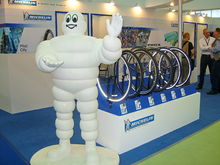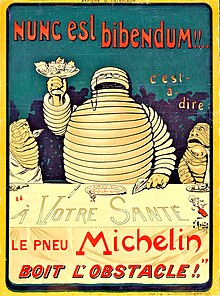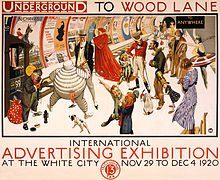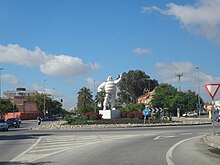Michelin Man


Bibendum[1] (French pronunciation: [bibɛ̃dɔm]), commonly referred to in English as the Michelin Man[2] or Michelin Tire Man, is the official mascot of the Michelin tire company. A humanoid figure consisting of stacked white tires, it was introduced at the Lyon Exhibition of 1894 where the Michelin brothers had a stand.[3] He is one of the world's oldest trademarks still in active use. The slogan Nunc est bibendum ("Now is the time to drink") is taken from Horace's Odes (book I, ode xxxvii, line 1). He is also referred to as Bib or Bibelobis.[4]
Michelin dominated the French tire industry for decades and remains a leading international tire manufacturer. Its famous guidebooks are widely used by travelers. Bibendum was depicted visually as a lord of industry, a master of all he surveyed, and a patriotic exponent of the French spirit. In the 1920s, Bibendum urged Frenchmen to adopt America's superior factory system, but to patriotically excel those factories' "inferior" products. As automobiles became available to the middle classes, the company's advertising followed suit, and its restaurant and hotel guides expanded to a broader range of price categories.[5]
Development
[edit]
While attending the Universal and Colonial Exposition in Lyon in 1894, Édouard and André Michelin noticed a stack of tires that suggested to Édouard the figure of a man without arms. Four years later, André met French cartoonist Marius Rossillon, popularly known as O'Galop, who showed him a rejected image he had created for a Munich brewery[6] — a large, regal figure holding a huge glass of beer and quoting Horace's phrase Nunc est bibendum ("Now is the time for drinking").[7] André immediately suggested replacing the man with a figure made from tires, and O'Galop adapted the earlier image into Michelin's symbol. Today, Bibendum is one of the world's most recognized trademarks, representing Michelin in over 170 countries.[8] According to Michelin, a study showed that 90% of the world’s population could instantly recognize him.[9]
The 1898 poster showed him offering the toast Nunc est bibendum to his scrawny Brand X competitors with a glass full of road hazards, with the title and tag C'est à dire : À votre santé. Le pneu Michelin boit l'obstacle (see illustration).[10] The character's glass is filled with nails and broken glass,[11] implying that Michelin tires will easily take on road hazards.
The company used this basic poster format for 15 years, adding its latest products to the table in front of the figure. It is unclear when the name "Bibendum" was adopted. At the latest, it was in 1908, when Michelin commissioned Curnonsky to write a newspaper column signed "Bibendum". In 1922, Michelin held a contest to name the character in the United States.[12]
Rubber tires were originally gray-white, or light or translucent beige. In 1912, they became black when carbon was added to them as a preservative and strengthener.[13] The company changed Bibendum's colour to black as well,[citation needed][14] and featured him that way in several print ads. They decided to abandon the change, citing printing and aesthetic issues (not racial concerns, as is commonly believed).[citation needed]
The image of the plump tire-man is sometimes used to describe an obese person, or someone wearing comically bulky clothing (e.g. "How can I wrap up warmly without looking like the Michelin Man?").[15]
Bibendum's shape has changed over the years. O'Galop's logo was based on bicycle tires, wore pince-nez glasses with lanyard, and smoked a cigar. By the 1960s, Bibendum was shown running, often rolling a tyre as well, and no longer smoked. In 1998, his 100th anniversary, a slimmed-down version of him (sans glasses) was adopted, reflecting the lower-profile, smaller tires of modern cars. An animated version of Bibendum has appeared in American television ads, with a pet puppy similar in appearance to him.
A history of Bibendum, Le Grand Siècle de Bibendum (Hoëbeke, Paris, 1997), was written by Olivier Darmon.[16]
In popular culture
[edit]
The "Bibendum chair" was designed by Eileen Gray in 1925.[17]
Cayce Pollard, the main character of William Gibson's novel Pattern Recognition, has a strong aversion to corporate brands and logos. The sight of Bibendum in particular gives her panic attacks.[18]
Bibendum made a brief guest appearance in the Asterix series, as the chariot-wheel dealer in certain translations, including the English one, of Asterix in Switzerland. (The original French version used the Gaulish warrior mascot of French service-station company Antar.)
The mascot appears in a BBC Not the Nine O'Clock News comedy sketch, in which a restaurant waiter, and chef suspect a diner, dressed as Bibendum, might be a food critic for the Michelin Guide.[19]
Michelin sued the performance artist Momus in 1991 for releasing a song about the trademarked Michelin Man.[20][21] The song, simply titled "Michelin Man", was released the same year as the third track on his album Hippopotamomus (which also had a hippopotamus-headed version of the Michelin Man on its cover) used the mascot as a metaphor for hypersexual rubber fetishism.[22][21] The use of the Michelin Man in such explicit lyrics were not authorized by the Michelin company, and Momus was sued by the company for depicting their mascot in scenarios of a pornographic nature.[23][21] As a result, all remaining copies of the album were destroyed, the song was removed from subsequent pressings of the album, and the hippo Michelin Man removed from the cover.[24][21] The 2018 box set Recreate (containing some of Momus' albums, including the Hippopotamomus album that caused the lawsuit over his song) restored the track to the album, and came with a booklet by Anthony Reynolds titled 'Sons of Pioneers', mentioning the lawsuit but not explaining why the track was reinstated.[25]
French reggae band Tryo sang about Bibendum on their album Grain de Sable. 'Monsieur Bibendum, il est vraiment énorme / Monsieur Bibendum, le bonheur en personne' ('Mr. Bibendum, he is truly enormous, Mr. Bibendum; happiness personified').
In the 2009 animated, Academy Award-winning satire Logorama, a series of Bibendums play police detectives, a sheriff, and a squad of SWAT personnel who all work together to try to bring down a psychotic, ultraviolent criminal played by Ronald McDonald.[26]

In the French dubbed version of Ghostbusters, the giant Stay Puft Marshmallow Man is named "Bibendum Chamallow". ("Chamallow" was originally a confectionery marketed in France under this name, which vaguely resembles the American marshmallow.)
In the Australian Army Training Establishment at Royal Military College, Duntroon, in Canberra, one of the five training companies, Gallipoli Company, uses the Michelin Man as its mascot. The reasons behind this involve an officer candidate who was sent to Turkey for a commemoration of World War One, and told to bring back a meaningful souvenir, but after heavy alcohol consumption instead stole the Michelin Man from the local garage.[citation needed]
References
[edit]- ^ "How the Michelin man logo came to be". Creative Review. 2011-03-30. Retrieved 2024-05-23.
- ^ "Explore Michelin Tires, Products & More | Michelin". www.michelinman.com. Retrieved 2024-05-23.
- ^ "L'Aimable Mons. Bibendum or Quelques Precisions sur le Guide Michelin". The Motor. nbr 3503: 41. 9 August 1969.
- ^ "Michelin Corporate - Bibendum, the Michelin man, the living tyre". Archived from the original on 2010-06-18. Retrieved 2010-05-28.
- ^ Stephen L. Harp, Marketing Michelin. Advertising and Cultural Identity in Twentieth-Century France (Johns Hopkins University Press, 2001)
- ^ Peterson, Hayley (December 11, 2013). "These Terrifying Photos Of The Original Michelin Man Will Haunt Your Dreams". Business Insider. Retrieved 2023-10-18.
- ^ Horace, Odes, Book 1, Poem 37.
- ^ "About the MICHELIN Company". MICHELIN Guide. Retrieved 2024-06-14.
- ^ "History of the Michelin Man Mascot". michelinman.com. September 11, 2023. Retrieved May 9, 2024.
- ^ Cross, Mary (2002). A Century of American Icons: 100 Products and Slogans from the 20th-Century Consumer Culture. Greenwood Press. pp. 31–34. ISBN 978-0313314810. Retrieved 4 September 2020.
- ^ Dotz, Warren; Morton, Jim (1996). What a Character! 20th Century American Advertising Icons. Chronicle Books. p. 25. ISBN 0-8118-0936-6.
- ^ advertisement, Saturday Evening Post 194:56 (March 4, 1922), p. 53
- ^ "Michelin Man: The Inside Story - September 19, 2005".
- ^ Design Evolution: Michelin Man – Advertising Week
- ^ Brodkin, Jon (2006-10-06). "Kenny has a big pair of gloves to fill on Ireland's twin mission". The Guardian. London. Retrieved 2010-05-12.
- ^ Also in English and German: One Hundred Years of Michelin Man; translated from the French by Bernard Besserglik; Paris: Hoëbeke, 1997; Michelin Man: 100 years of Bibendum; London: Conran Octopus, 1998.--Bibendum: ein Jahrhundert Geschichte; aus dem Französischen von Herta Luise Ott.
- ^ Otero, Rosa (2014-04-23). "Eileen Gray's Bibendum: A Modern but Feminine Chair". Bienenstock Furniture Library. Retrieved 2024-01-14.
- ^ Gibson, W. (2003). Pattern Recognition . Penguin.
- ^ Not the Nine O'Clock News clip on YouTube
- ^ Anthony Reynolds (2018) Sons of Pioneers Cheery Red pp.9-10
- ^ a b c d Shepherd, Fiona (10 September 1999). "The World Can Change in a Matter of Momus". The Scotsman. UK. p. 23. Archived from the original on 28 March 2015. Retrieved 15 April 2013 – via HighBeam Research.
- ^ Anthony Reynolds (2018) Sons of Pioneers Cheery Red pp.9-10
- ^ Anthony Reynolds (2018) Sons of Pioneers Cheery Red pp.9-10
- ^ Anthony Reynolds (2018) Sons of Pioneers Cheery Red pp. 9-10
- ^ Anthony Reynolds (2018) Sons of Pioneers Cheery Red pp.9-10
- ^ Adam, Orestes (2023-08-11). "This Oscar-Winning Short Built a Chaotic World Entirely Out of Logos". Collider. Retrieved 2024-09-15.
External links
[edit]- Bibimage.com, Unofficial site dedicated to Bibendum. (in French)
